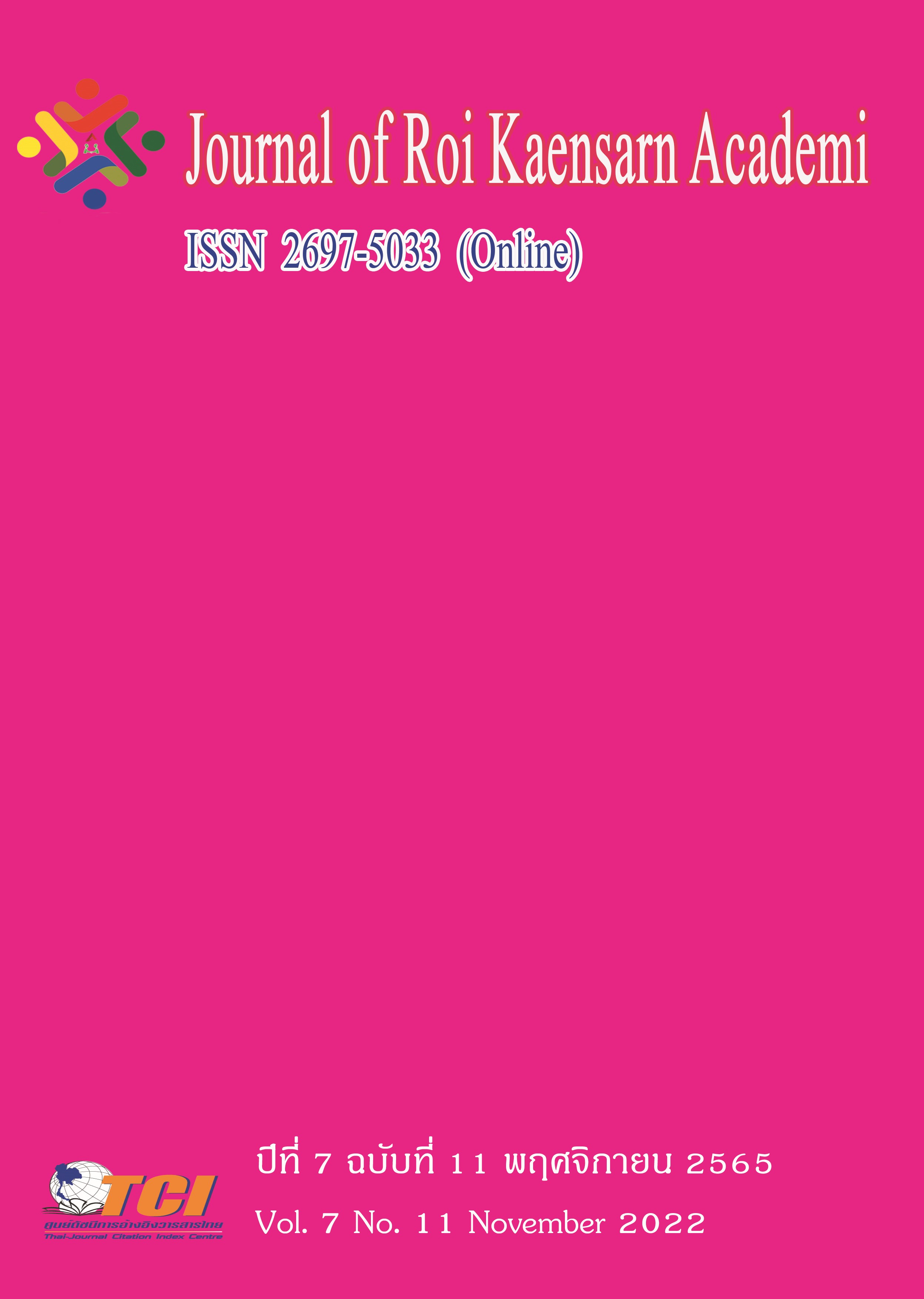Is Globalization a Threat or Opportunity to the Local Culture of Spirit Worship?
Main Article Content
บทคัดย่อ
Globalization has several impacts on everyday life that change our habits by the information we receive. The modern-day young generation receives the foreign culture as a soft power. For example, Korean culture, which is K-pop or Animation from Japan. The foreigner's cultures are not perturbing the local culture at the moment. However, it is will slowly intervene as a soft power. As a result, young generation is interested in the foreigner's culture rather than the local traditional Thai culture. On the other hand, we can use the benefit of globalization to spread the information about culture to raise the awareness of preserving the culture.
Article Details
เอกสารอ้างอิง
Beng Huat Chua. (2012). Structure, audience and soft power in East Asian pop culture. Hong Kong Univ. Press.
Croucher, S. L. (2018). Globalization and belonging : the politics of identity in a changing world. Rowman & Littlefield.
Chareonwongsak, K. (2002). Globalization and technology: how will they change society? Technology in Society, 24 (3), 191–206.
Feigenbaum, H. B. (2002). Globaloney: Economic Versus Cultural Convergence Under Conditions of Globalization. The Journal of Arts Management, Law, and Society, 31 (4), 255–264.
Jougcharnsittho, P. (2020). Tribal cloth in Lanna : Pattern, beauty and value of handicrafts of marginal people. Walailak Abode of Culture Journal 2020, 20 (1), 26–39.
Li Renliang. (2014). The Development of Chinese Society with Innovation Management in the Cause of Reforming Deeply and widely: Forecasts and Analysis of the Chinese Society in the Year 2013 -2014. Journal of Social Development, 16 ( 2), 90–102.
Junglin, C. (2019). In-Groups Bias On Performance Result ( 5–23).
Karavekphan, B., Wattana, P., & Tanavarit, T. (2019). Research Paper on the perception of Thai contemporary arts and how it can strengthen the society: Thai Youths’ Perception on Thai Contemporary Arts vis-à-vis foreign contemporary arts 2017. Rajapark Journal, 13 (28), 83–95.
Kanchanapradit, J. (2014). The Loss of musical instruments of Lai-vo Karen. Journal of Fine an Applied Arts, Khon Kaen University, Vol. 06 No.1, 1–23.
Ketprom, S. (2015). spirit of the lanna city. Khuangpaya: The Journal of Thai Lanna Wisdom, Year 10 (2), 32–55.
Kumpha, A. (2012). Pu SaeYa Sae with the Ritual of Spirit Worship of Chiang Mai. Suranaree Journal of Social Science, Vol.6 (No.2), 99–122.
Litvin, S. W., & Fetter, E. (2006). Can a festival be too successful?A review of Spoleto, USA. International Journal of Contemporary Hospitality Management, 18 (1), 41–49.
Lua - Office of the Promotion of Arts and Culture Chiang Mai University. (2020). The Center for the Promotion of Arts and Culture, Chiang Mai University. Online. Retrieved November 8, 2021, from https://artculture.cmu.ac.th/Lanna/articleDetail/1255
Mahler, V. A. (2004). Economic Globalization, Domestic Politics, and Income Inequality in the Developed Countries. Comparative Political Studies, 37 (9), 1025–1053.
Phra Pasitthideth Chaleunsouk. (2019). Analysis On The Philosophical Belief In Phee Dong Ritual Tradition.Academic Journal of MBU Lanna ; Campus, 8, 29–33.
Potiwan, P. (2016). Social Space Construction of Spirit’s Isanใ Journal of Cultural Approach, 32 (8), 100–110.
Phraatikarn Pankaew Indhapañño. (2021). A study of Praying for Rian in Lanna by Study of the Kaen chan Buddha Image Parade Ceremony, Wat Pa Tan Luang, Maeta dictric, Lampang Province. Journal of MCU Haripunchai, 5 (1), 32–39.
PraathikanThipphanet Panyateepo, Phrakru Sirisutapon, & Phramaha Nattakitti Anarado. (2019). An Analytical Study on the Ritual of Worshiping and Beliefs about Ta - Kheag Ghost in Community Kasem Sub-Districttrakanphuetphon District Ubon Ratchathani Province. Journal of Arts Management, 3 (1).
Sae-Wang, R. (2017). Cultural Heritage Management in Thailand: Common Barrier and the Possible Way to Survive. Journal of Social Sciences, Humanites, and Arts, Vol.17 No.1, 133–160.
Seangtian, N., & Sodsongkrit, M. (2017). Reflections of Chinese Governmental Communications for Hospitality in Chinese Culture. JOURNAL of LANGUAGE, RELIGION and CULTURE, 6 (2), 185–220.
Stefano, M. L., Davis, P., & Corsane, G. (2014). Safeguarding intangible cultural heritage. The Boydell Press.
Sukvun, P. (2008). A Change of Relationship between Cultural Arts and a Community, s Way of Life: A Case Study of Wat Wieng Community, Tambon Wieng, Amphoe Chaiya, Surat Thani. Journal of Humanities and Social Sciences, 4 (2), 105–129.
Sungworachat, S. (2002). Gender relations in matrifocal community in a transitional society : A case study of Banrai village Mae-Cham district Chiang Mai province. (p. 280).
Sutinyamanee, V. (2015). Rural to Urban: Factors and Effects from Migration. KASEM BUNDIT JOURNAL, 1 (8), 102–112.
Suwannual, P., & Phrapalad Raphin Phutthisaro. (2021). Community Management According To Sangkhahawatthu 4 Principles. Journal of MCU Nakhondhat, 8 (2), 325–336.
The tradition of raising the Spirit of Khun Nam. (2020). Ministry of Culture. Retrieved November 3, 2021, from https://www.m-culture.go.th/th/article_view.php?nid=34396
Torsee, T., Yensabai, A., Tungcharoen, W., & Surasonthi, K. (2017). The Meaning and Existence of the believe in “Pee Pob” in Thai society.Research and Development Journal Suan Sunandha Rajabhat University, 9 (2).
Unesco. (2020). Basic Texts of the 2003 Convention for the Safeguarding of the Intangible Cultural Heritage,2020 Edition.
UNESCO - Browse the Lists of Intangible Cultural Heritage and the Register of good safeguarding practices. (n.d.). Ich.unesco.org. https://ich.unesco.org/en/lists?text=&country
Vajirañaṇo, C. (2021). Lanna Tung: Iconography of Buddhism [Review of Lanna Tung: Iconography of Buddhism. Journal of Buddhist Arts, 4 (1), 1–16.
Woolnough, G. (2014). Blood Sports in Victorian Cumbria: Policing Cultural Change. Journal of Victorian Culture, 19 (3), 278–294.

